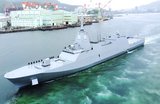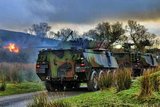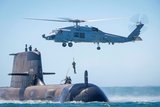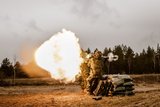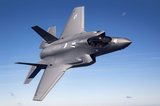US outlines foreign policy in Global Posture Review
The GPR outlines the continued involvement of the US in supporting counter-narcotic missions. The vessel above seized approximately 7,900lb of marijuana and 300lb of cocaine in 2019. (Photo: USCG)
The US DoD has released its Global Posture Review (GPR), which aims to determine military posture around the world, using input from all branches of government and international allies and partners.
It comes at a key moment, following the end of operations in Afghanistan and the ongoing development of the National Defense Strategy.
The review’s assessments will help strengthen posture decision-making processes, improve global response capability and inform the draft of the next National Defense Strategy.
In the Indo-Pacific region, the review advises additional cooperation with regional partners to deter Chinese aggression and threats from North Korea.
There are plans to enhance infrastructure in Australia and the Pacific islands while implementing rotational aircraft deployments in Australia.
Meanwhile, a previously rotational deployment of an attack helicopter squadron and artillery division headquarters in South Korea will become a permanent stationing.
In Europe, the GPR pushes to strengthen the US combat-credible deterrent against Russian aggression and enable NATO forces to operate more effectively.
Based on initial assessments made as part of the review, President Biden rescinded the 25,000 active-duty force cap in Germany established by the previous administration.
There will also be a permanent stationing of an Army Multi-Domain Task Force and a Theater Fires Command, a total of 500 personnel, in Germany.
In Africa, the US will continue to monitor threats from regional violent extremist organisations to support allies and partners, while in the Caribbean and Central and South America, Washington will continue to provide humanitarian assistance, disaster relief and support counter-narcotic missions.
More from Defence Notes
-
![Canada to deepen integration of multi-domain capabilities to strengthen its defences]()
Canada to deepen integration of multi-domain capabilities to strengthen its defences
The Canadian Department of National Defence has created new organisations to manage the procurement and integration of all-domain solutions and allocated US$258.33 million to strengthen production capacities.
-
![US National Security Strategy prioritises advanced military capabilities and national industry]()
US National Security Strategy prioritises advanced military capabilities and national industry
The 2025 NSS has emphasised investment in the US nuclear and air defence inventory and national industry, but it leaves multiple unanswered questions on how the White House will implement this approach.
-
![Canada set to look away from its neighbour and across the Atlantic for partners]()
Canada set to look away from its neighbour and across the Atlantic for partners
While non-EU UK struggles to join the Security Action for Europe initiative, which provides loans for defence programmes, Canada has become the first country outside Europe to get access – and did so for a nominal fee.
-
![NATO experiments with solutions to integrate networks, AI and uncrewed systems]()
NATO experiments with solutions to integrate networks, AI and uncrewed systems
During the latest edition of the NATO DiBaX, the alliance tested multiple capabilities to inform requirements for future efforts.
-
![Leonardo unveils plans for Michelangelo air defence dome]()
Leonardo unveils plans for Michelangelo air defence dome
The new multi-layered defence system will harness AI to neutralise airborne threats and protect Europe from Russian aggression.









